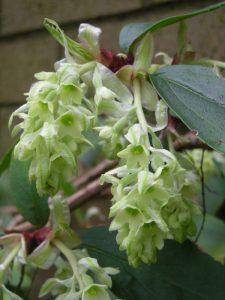An evergreen shrub with leathery leaves, Ribes laurifolium is a native of west China, introduced to Britain in 1908 by Ernest Wilson. The flowers are produced in racemes that elongate pendulously over a week of warm weather to 75-80mm in length. When in tight bud, these are more attractive than the extended inflorescence at maturity.
The flowers take on a white appearance en mass, however each of the five petals and central boss has a distinct lime-green shade. These are fused at the base from where the single sepal arises, acting as a shield to the individual flower.
Planted opposite the Arid Land House, tucked away on a south-facing wall beneath a canopy of vegetation, this evergreen is thriving on dappled sunshine. The nectaries at the base of the individual flowers are glistening with liquid, sweet to the taste. In the nectar pool are splashes of orange colour, invisible to the naked eye, resembling vestigial anther heads. Most descriptions of this plant describe it as dioecious, that is male and female flowers produced on separate plants. In these images, taken through a light microscope in the Garden’s SEM Suite (6.5 x magnification) by Frieda Christie, distinctive anthers can be seen, held free from the petals with a short filament strand.
The plant is slow to establish but will grow to about 1.8 metres with weak woody shoots when cultivated successfully. It is best grown through or up a support, allowing the pendulous flowers to be seen to full advantage.



Telkom Jakarta
In which country can you find the most flowers?